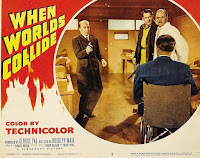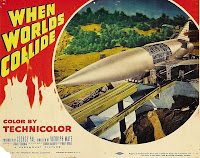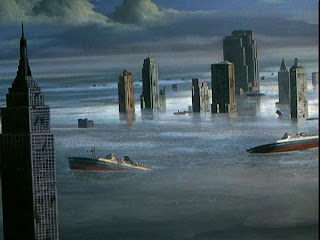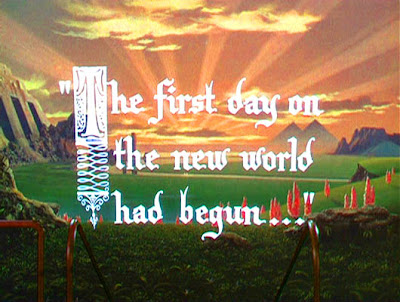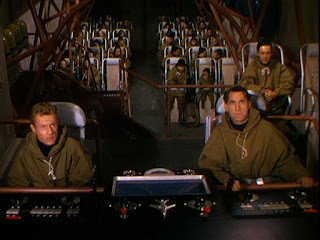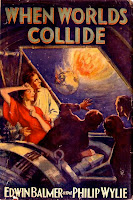 So, a couple of evenings ago my buddy Chuck and I got on the topic of remakes. Now, he and I just happened to be enjoying one of our favorite Seattle watering holes (it's the only place that makes a Dark 'n' Stormy with precisely the right kind and amount of bitters to my liking).
So, a couple of evenings ago my buddy Chuck and I got on the topic of remakes. Now, he and I just happened to be enjoying one of our favorite Seattle watering holes (it's the only place that makes a Dark 'n' Stormy with precisely the right kind and amount of bitters to my liking).Specifically, we were rambling on about remakes of classic science fiction movies (or at least vintage sf movies that are fondly remembered and respected, even if chiefly in an "inside baseball" way among sf aficionados). James Cameron's upcoming Fantastic Voyage redo is a case in point.
While it's a subject close to our hearts, Chuck's ventricles are more explosive about it than mine. So I should have predicted that the conversation would take a turn toward the coronary when we got to the 2008 Keanu Reeves mutation of 1951's The Day the Earth Stood Still, one of the most revered films in the sf canon. I merely groaned and shook my head, maybe shrugged in an "eh, what can you do?" way. Chuck, however, so affronted by the mere mention of Keanu-as-Klaatu, gesticulated with great emphasis but piss-poor aim, slapshotting his glass of stout across the table and sending half its contents like a black, foamy surf onto the floor, the other half onto an older gentleman at the next table.
 Mortified, we distributed napkins and, with the help of the put-out server, mopped up the wet exclamation point. The gentleman who received a free beer on his pants leg was gracious about it, although he did seem to finish his burger and depart rather hastily, perhaps anticipating Chuck's inevitable outburst regarding the 2002 Guy Pearce remake of The Time Machine. (I pulled Chuck's refilled glass protectively toward me during that one.)
Mortified, we distributed napkins and, with the help of the put-out server, mopped up the wet exclamation point. The gentleman who received a free beer on his pants leg was gracious about it, although he did seem to finish his burger and depart rather hastily, perhaps anticipating Chuck's inevitable outburst regarding the 2002 Guy Pearce remake of The Time Machine. (I pulled Chuck's refilled glass protectively toward me during that one.) The subject of The Day the Earth Stood Still led to two other favorites from 1951 that have received, or soon will, the remake treatment. One was the Hawks/Nyby The Thing from Another World. The other: the grandfather of apocalyptic doom movies, When Worlds Collide.
As a movie When Worlds Collide never was as good as those others, so to say it hasn't aged as well as they have just underlines the obvious. All the same, it remains a worthy and entertaining period-specific, second-tier title. Add the sublime The Man in the White Suit and we get a roster of films that reveals 1951 as one of the strongest years for science fiction on our screens.
When Worlds Collide was producer George Pal's second popular special-effects extravaganza after Destination Moon, and arriving years before The War of the Worlds, The Time Machine, and others he contributed to the sci-fi/fantasy Hall of Fame.
While Pal's movie is a memorable representative of genre films from its time and place, his source material had already been around a while. Paramount first purchased Philip Wylie and Edwin Balmer's 1932 novel When Worlds Collide in '34 as a project for Cecil B. DeMille. For better or worse, De Mille chose to make Cleopatra instead and today we can only dream about how he would have done it.
The remake is slated for 2012, no doubt to ride the already-sick-of-it "Mayan Calendar end-of-the-world prophecy" marketing wave. Cultish paranoia and brain-dead superstition as a Hollywood PR tool — charming. Steven Spielberg is listed as one of its three producers (yay), as is the remake's writer-director, Stephen Sommers. I could really use a stiff Dark 'n' Stormy right about now.
Sommers may be a delightful man who throws great parties, tells hilarious jokes, can pick up a guitar and sing sad songs that make you cry with heartbreak, and folds origami cranes that'll knock your socks off. But his track record as a writer-director leaves me wincing. G.I. Joe: The Rise of Cobra? Van Helsing? The Mummy: Tomb of the Dragon Emperor? Revenge of the Mummy: The Ride?
 Fine. Fine. The proof will be in the pudding, as they say, and the pudding's not even out of the Jell-O Instant box yet. Besides, I'd be naive to expect a When Worlds Collide remake to be anything but a familiar, by-the-numbers, Hero's Journey disaster-movie formula with simply a bigger bang on page 85. But I remain hopeful, cautiously optimistic. I raise my glass to you, Mr. Sommers, and to your latest opportunity to take out the Eiffel Tower. Just make it cool. Smart would be nice too. And layered. And no obvious product placement ads. Just a request.
Fine. Fine. The proof will be in the pudding, as they say, and the pudding's not even out of the Jell-O Instant box yet. Besides, I'd be naive to expect a When Worlds Collide remake to be anything but a familiar, by-the-numbers, Hero's Journey disaster-movie formula with simply a bigger bang on page 85. But I remain hopeful, cautiously optimistic. I raise my glass to you, Mr. Sommers, and to your latest opportunity to take out the Eiffel Tower. Just make it cool. Smart would be nice too. And layered. And no obvious product placement ads. Just a request.Like Fantastic Voyage, When Worlds Collide is material ripe for a modern remake. Never mind the overhyped 2012 Doomsday angle — the opportunity to send celestial bodies bearing down on planet Earth, heaving cities and entire continents like chessboards kicked by a six-year-old, and finally splitting open our planet from molten core to Lady Gaga's chartreuse hot tub ... well, face it, that's just irresistible. And you know it'll be in 3-D (unless that already tiresome innovation is utterly played out by 2012, whether or not it's the Mayans' fault).
1951's When Worlds Collide roasts all of humanity (well, 99.99999%) with a cataclysmic conflagration caused by the impact of the rogue star Bellus. Fortunately, forty-four survivors, most chosen by lottery, manage to escape in an atomic-powered rocketship Space Ark built in those last desperate months. Humanity begins again on Bellus's companion planet, Zyra, an Edenic new world safe from fear, celestial collisions, and apparently anyone who isn't wholesome American white folk. More on that last point in a bit.
After World War II and throughout the Cold War, end-of-the-world stories unzipped the zeitgeist to become a prominent subgenre, and When Worlds Collide is to apocalypses what The War of the Worlds is to alien invasions — a venerable elder of the tribe in the form of a taut real-world drama featuring never-before-seen special effects, in-your-face biblical allusions, a few pointed observations on mindless mob hysteria ("It's dog eat dog! The law of the jungle!"), a melodrama love triangle, scenes of mass destruction, and a science-as-questionable-savior subtext. What's more, Pal brought it all in for under a million bucks.
When the Bible crossfades to starry space, a stentorian voice-over segues us to the "men of science" at the remote observatory where "the most frightening discovery of all time" — the unstoppable collision course of Bellus and Zyra — sets events in motion right away.
 In terms of stock characters, When Worlds Collide delivers the goods. (Ten to one the remake will too.) Paramount star Richard Derr plays the square-jawed aviator protagonist who also makes a fine rocket pilot right when we need one. Other tropes from Central Casting include the Noble Scientist, the Government Officials who remain willingly blind until It's Too Late, the Self-Centered Millionaire ("Your salvation doesn't interest me; mine does!"), the Self-Sacrificing Young Man, and the Pretty Girl (Barbara Rush) who happens to be the daughter of the Head Scientist (Larry Keating). I particularly love the street-corner newsboy clutching his stack of papers and shouting, "Read all about it! End of the world just around the corner!"
In terms of stock characters, When Worlds Collide delivers the goods. (Ten to one the remake will too.) Paramount star Richard Derr plays the square-jawed aviator protagonist who also makes a fine rocket pilot right when we need one. Other tropes from Central Casting include the Noble Scientist, the Government Officials who remain willingly blind until It's Too Late, the Self-Centered Millionaire ("Your salvation doesn't interest me; mine does!"), the Self-Sacrificing Young Man, and the Pretty Girl (Barbara Rush) who happens to be the daughter of the Head Scientist (Larry Keating). I particularly love the street-corner newsboy clutching his stack of papers and shouting, "Read all about it! End of the world just around the corner!"John Hoyt as the wheelchair-bound, Mr. Burns-like millionaire is the most familiar of the "Wasn't he on I Dream of Jeannie?" faces here. To me he'll always be the three-armed Martian invasion scout in the Twilight Zone episode "Will The Real Martian Please Stand Up" and Dr. McCoy's precursor on Star Trek. For extra barroom Trivia Night points, look for Kirk Alyn, the first screen Superman, as Rioter Bringing Guns.
The script packs them all into 82 minutes, and former cinematographer Rudolph Maté directed with straight-ahead booster-rocket pacing. The script would fall apart under a single gust of logic, and it reminds us that Hollywood bears a long history of characters behaving, no matter how irrationally or ridiculously, strictly according to the dictates of the plot imposed upon them like bad source code. So never mind nuanced characters or realist naturalism, and don't think too hard, if at all, about the "sci" component of the sci-fi equation.
The main attractions here are (1) producer Pal, who had found the niche that would make the phrase "a George Pal movie" readily identifiable to fans right up to today, and (2) the Oscar-winning special effects.
Forget testosterone-addled crap like Armageddon or emo half-ways like Deep Impact. As the approaching Bellus grows ominously in the sky day by day and the calendars are rewritten to countdown Doomsday, Pal rumbles earthquakes and unleashes volcanoes and deluges coastal metropolises (ocean liners, tipped on their sides, drift past the top floors of Manhattan landmarks) and then bakes and boils the whole damn planet, making it look like Hell itself on the rocketship's viewscreen.
Forget testosterone-addled crap like Armageddon or emo half-ways like Deep Impact. As the approaching Bellus grows ominously in the sky day by day and the calendars are rewritten to countdown Doomsday, Pal rumbles earthquakes and unleashes volcanoes and deluges coastal metropolises (ocean liners, tipped on their sides, drift past the top floors of Manhattan landmarks) and then bakes and boils the whole damn planet, making it look like Hell itself on the rocketship's viewscreen.
Regrettably, after a rough landing amongst the snowy hills of Zyra, the anticlimactic closing moments on this new Eden look more than a little cartoonish and hastily rendered. Nobody stepping out to view "the first sunrise" so much as mentions the pyramids in the distance or the monolithic temple-like structure in the foreground. (The stagehand whose shadow slinks out of frame might have been blocking the view.)
And if there's any post-traumatic stress over the billions of friends, family, and other fellow human beings who've just been incinerated, not to mention all earthly history and civilizations, it apparently evaporates with the birth of puppies. ("And they're all mine!" proclaims the little orphan boy who clutches the pups as their poor mother looks on helplessly. Yes, that's the sort of attitude we need to start Humanity 2.0.)
Nonetheless, you don't need the Sunday-school vibe or the Bible font overlay graphics to tell you that here's the perfect place for a stressed-out civilization to start anew — without, um, all those darn foreigners to mess things up again.
And that's a point about When Worlds Collide I've never seen commented on before. Although we're told that the survivors were selected by a worldwide lottery, there doesn't seem to be much that's multicultural, multi-ethnic, or multi-anything, except maybe their haircuts, about the "fortunate few" on the salvation express. In the middle of the film there's a handwaving reference to "similar rocketships are also being constructed in other countries," but that's the last we hear about them and the rest of the movie tracks as if only the one Ark escapes Earth's fate. As far as I can tell, the repopulation of humanity is up to about three dozen residents of an Omaha suburb.
I'm not suggesting any overt racist directive from Paramount or Pal here. In 1951 that would have been like directing a fish to swim in water. The peak civil rights struggles were still more than a decade away, and even today you don't have to travel farther than your nearest Fox News or a Tea Party rally to find manifest fear of the Other. In the 1950s, mainstream audiences might flock to the movies to witness the End of the World with fire, brimstone, and the heaven-sent eradication of, to boil it down, everyone else on Earth — but polluting Adam-and-Eve Redux with "race mixing"? Now that's just unacceptable!
Perhaps those other Arks "constructed in other countries" are bringing up the rear, or non-WASPs were told to wait for the next passing planet to come along. I chuckle to imagine a "race movie" version of When Worlds Collide aimed at African American moviegoers (a common practice for decades), in which the demographics of the survivors are reversed.
Let's ride along with the notion that any racist undertones and unsubtle sociology in Pal's movie are just byproducts of the era's ingrained audience expectations, the pervading background radiation of social conditioning. However, the original novel, and especially its sequel After Worlds Collide, made no bones about leaving behind all those "inferior" races to burn. After Worlds Collide adds a threatening Yellow Peril, the "Dominion of Asian Realists," who land on the new world in their own Ark and quickly enslave survivors of the British Ark, then try to bomb the American domed settlements.
 Much breast-beating is occasioned by the existential conflict between the Psalm-quoting survivors against the invading "Midianites" — an Old Testament term our lead characters apply to the "Japs," Russians, and some Germans, described as "cold, cruel, and inhuman" fanatics who "believe in nothing of the individual." Of course these Red Scare-era cartoon baddies "mean to conquer us." Even worse, their "desire for our women," we are informed, includes "what they call 'breeding females'." Naturally, the book ends with the non-Anglos defeated and governed under the thumb of an American-British coalition.
Much breast-beating is occasioned by the existential conflict between the Psalm-quoting survivors against the invading "Midianites" — an Old Testament term our lead characters apply to the "Japs," Russians, and some Germans, described as "cold, cruel, and inhuman" fanatics who "believe in nothing of the individual." Of course these Red Scare-era cartoon baddies "mean to conquer us." Even worse, their "desire for our women," we are informed, includes "what they call 'breeding females'." Naturally, the book ends with the non-Anglos defeated and governed under the thumb of an American-British coalition.
Let's be grateful that whatever 1930s-'50s cinema might have done with all that was never tested. Here's counting on Stephen Sommers to at least approach the subject with a less objectionable 21st-century sophistication.
 Much breast-beating is occasioned by the existential conflict between the Psalm-quoting survivors against the invading "Midianites" — an Old Testament term our lead characters apply to the "Japs," Russians, and some Germans, described as "cold, cruel, and inhuman" fanatics who "believe in nothing of the individual." Of course these Red Scare-era cartoon baddies "mean to conquer us." Even worse, their "desire for our women," we are informed, includes "what they call 'breeding females'." Naturally, the book ends with the non-Anglos defeated and governed under the thumb of an American-British coalition.
Much breast-beating is occasioned by the existential conflict between the Psalm-quoting survivors against the invading "Midianites" — an Old Testament term our lead characters apply to the "Japs," Russians, and some Germans, described as "cold, cruel, and inhuman" fanatics who "believe in nothing of the individual." Of course these Red Scare-era cartoon baddies "mean to conquer us." Even worse, their "desire for our women," we are informed, includes "what they call 'breeding females'." Naturally, the book ends with the non-Anglos defeated and governed under the thumb of an American-British coalition.Let's be grateful that whatever 1930s-'50s cinema might have done with all that was never tested. Here's counting on Stephen Sommers to at least approach the subject with a less objectionable 21st-century sophistication.
Paramount's DVD edition of When Worlds Collide has no special features, but it should please the film's fans until a more definitive edition comes along in — I'll hazard a guess — the month before the remake's premiere in 2012. Telltale flecks and momentary color shifts give away the fact that this edition was not digitally restored in any way, but the 1:37 flat full-frame transfer is fine, the definition is sharp, and the print itself is reasonably clean and free of wear. The Technicolor palette is rich and vivid. Likewise, the audio is clean and okay-strong in monaural Dolby Digital 2.0. Even the theatrical trailer looks good.
Music: The Proclaimers, "I'm Gonna Be (500 Miles)"
Near at hand: Metropolis Maria robotrix bobble-head

